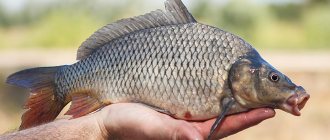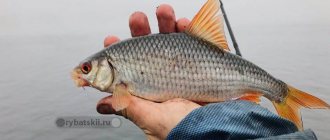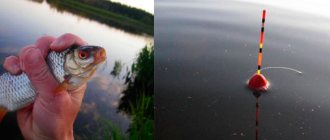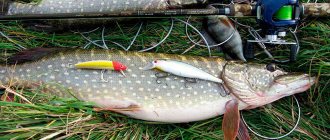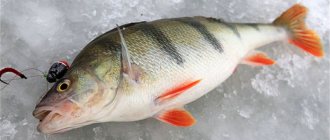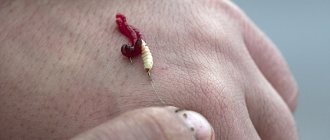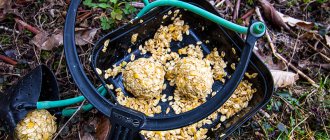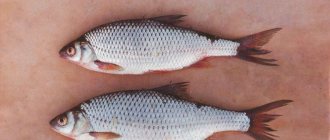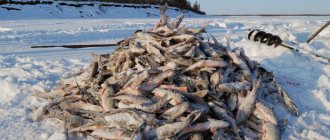Before we start talking about what the roach’s bite depends on, let’s try to understand in general terms what a roach is.
Roach is a fish that inhabits most freshwater bodies of water. Belongs to the family of carp fish. With the exception of sea roach, it is not of particular commercial value, but is one of the main fish species that is the object of sport and recreational fishing.
Roach
Roaches are divided into subspecies and have different names depending on their habitat:
- roach,
- ram,
- vobla,
- sorog,
- chebak,
- bagel,
- carpenter
- serushka,
- red-eye,
- flesh.
The rudd is called the rudd roach, but still, it stands out as a separate species of fish, although there are also hybrids. And if you start to carefully understand and study the subspecies of roach, it will become clear that there is no single classification.
- Roach on the first ice. Roach bite in winter
River and sea roach
Azov roach
There are river roaches and sea roaches, or rather, anadromous roaches that live in salty sea water and in fresh or mixed brackish water. Anadromous and semi-anadromous subspecies of roach are roach (Caspian sea roach), ram (Azov-Black Sea sea roach) and Aral roach. All other species are common roach leading a residential or sedentary lifestyle.
In some regions of the middle zone and to the north, river roach with a narrow body and yellow eyes is called chebak (Siberian roach), roach with a wider body and red eyes is called soroga (roach in the middle and upper Volga and some other places). In some places, large old bream is also called chebak.
Growth and size of roach. Large roach
The roach grows very slowly; in order to reach a weight of 300 grams, a river roach needs to live for about 10 years. Depending on the average water temperature and the abundance of food, roach grows slower or faster. The sea roach grows larger. It is the slow growth of roach that makes this fish not very attractive for commercial catch and cultivation, and therefore it is considered a weed in water bodies that are inhabited by valuable fish species.
The largest roach caught weighed 2.58 kg - a world record. The maximum weight of roach does not exceed 2.8 kg. In regular fishing, a roach weighing more than 200 - 300 grams is considered large, and the majority of the catch is fish weighing 100 - 150 grams. Large roaches adhere to schools of small ones, but are more cautious and timid.
Roach feeding
Roach is a peaceful fish that feeds on food of plant and animal origin - underwater vegetation, insect larvae, and mollusks. However, large roaches can also eat young fish. Roach and rudd are often caught using spinning rods.
Red roach
As bait for catching roach in the summer, anglers use a worm, maggot, canned corn, boiled pearl barley, dough or mash (semolina-based bait). In winter fishing, roaches are caught using reelless jigs, and when fishing with bait, bloodworms, maggots, jigs, and burdock moth larvae are used.
Bait for catching roach
Summer bait for catching roach consists of plant components and is made on the basis of ground crackers and wheat bran, to which are added various bite enhancers - attractants. The most famous bite activators are vanillin, milk powder, cocoa powder, coriander, and various flavorings.
Winter bait for catching roach differs from summer bait in the absence of large fractions and a reduced amount of any flavorings. In the absence of bites, winter bait for roaches is food bloodworms in its pure form.
Here is one of the many recipes for homemade universal bait for roaches:
Roach hook size
Considering that the sizes of hooks from different manufacturers differ from each other and often do not correspond to the international classification, we will give only general recommendations for choosing a hook for roach.
Hook size
The size of hooks for roach is selected in accordance with the size of the bait. The smallest ones are for fishing with bloodworms, medium ones for maggots, and larger hooks for worms and plant baits. For catching roach with a worm, hooks with a long shank are preferable; in other cases, hooks with a short shank are preferable. Larger hooks are also used for attaching a “bundle” or several plant baits.
In general, more delicate hooks are used for float fishing than for feeder fishing. In addition, you need to take into account the activity of the fish - the worse the bite, the thinner and smaller the hook should be.
With a spatula or a ring, the hook is just a matter of habit; it does not have much effect on the roach’s bite. One thing is important - the hooks must be sharp, thin and durable.
Fishing gear
The gear used for catching roach is a light rod 4-6 m long. If fishing is carried out close to the shore, the main line is tied to the tip of the rod. If you need to cast long distances, you will need a small spinning reel.
The thickness of the main line is 0.14-0.16 mm, and the diameter of the leader can vary between 0.1-0.12 mm.
The size of the hook is selected according to the size of the bait.
It is very important to accurately load the float so that the slightest touch of the fish is visible to the angler
- rod length 3.1-3.9 m with test 5-30 g;
- reel size 1500-2000;
- main line 0.2 mm;
- leash 0.5-0.8 m long and 0.14-0.16 mm thick.
The feeder can be attached to the main line using an anti-twist tube or a loop system.
For fishing on rivers, mesh metal feeders of triangular or rectangular shape are used. For fishing in standing water, feeders of any shape, made of any material, are suitable. Even homemade models made from plastic bottles are suitable for catching spring roach.
They catch the sorozhka in the spring with a float rod in the wiring, its usual equipment, fishing line and float, hook sinker. And now in more detail.
Since they fish with a fishing line, you have to hold the rod in your hands all the time, and if it is heavy, you may be left without hands by the end of the fishing. So the fishing rod should be as light as possible and about six meters long, the length also depends on the place where the fishing takes place.
The size of the river can significantly affect the size of the fishing rod. On a narrow river with a six-meter rod it will be inconvenient to fish and cast tackle.
When fishing for the track, I use a blind rig; in my opinion, it is more convenient in this situation. But someone may prefer it with rings and a coil.
- Rod: light match 4-6 meters, for fishing from the shore - a rigid rod.
- Line: monofilament, 0.16-0.20 mm in summer, 0.12 mm in autumn.
- Leash: from 0.1 mm to 0.15 mm.
- Hooks: small and thin from No. 3 to No. 10
- Bait: maggots, bloodworms, worms, corn, millet, semolina, bread.
- Complementary foods: white bread crackers, millet cereals, peas, anise, pigeon droppings, fennel, corn grains, peas.
Spring fishing with float tackle.
The best time for catching sorog (sorog) is considered to be spring, after the ice on the rivers has melted. For such fishing, a fishing rod 5 meters long is used, an inertial reel with a line reserve of 100 meters, this reel will allow you to fully control each wiring.
It is customary to use a fishing line diameter of 0.20 mm, as well as a lead-tipped summer jig. The float should have an elongated shape of medium size, and it should not slide.
We attach the sinker for the float in the form of a whip, about 3 or 4 pellets of different sizes and weights. We fix it by reducing the distance between them from large to small.
This is done so that the tackle moves at a slight angle. Mayfly or goose are used as bait.
This nozzle is washed with a strap made of fine mesh material on shallow riffles. At this time of year they are present in large numbers in the rivers.
The spring muddy water gives off very bright reflections, so don’t forget to take special glasses. Use a leash between the tackle that is a little longer than usual, this will make the bites more confident.
Constantly change the fishing depth - this is done in order to find that part of the water layer where the fish bite better.
www.ribalovu.ru
One of the most popular gear used to hunt for roach is a regular float rod. The fishing method is very simple, because it is a schooling fish. You just need to find a suitable place. They usually stop near willow trees, or in a place with a lot of vegetation. The fishing spot needs to be fed a little.
Suitable for this:
- Small pieces of worms
- Bread crumb
- Cake
- Flour
- Semolina or wheat groats
It is better if the fishing rod is equipped with several weights, then they will be able to play favorably and interest you. You can cast in a place with a weak current, which will move the bait itself, or near thickets of algae.
Fishing Tips
- The track is very careful, so you need to behave very quietly.
- It is better to use inconspicuous gear so as not to scare away the prey.
- The area needs to be fed, but in small quantities.
- You need to play the game as naturally, smoothly and accurately as possible.
- The track often moves around the pond, so it is better to take several gears with you and install them in different places.
- You should not use large floats or sinkers; the fish are very shy, and upon noticing them, they may not take the bait or swim away altogether.
Roach bite
Catching roach with a float rod
The roach bite depends on its activity at different times of the year, weather conditions and characteristics of the reservoir - all these are objective factors influencing the fish bite.
During the year, there are two bursts of roach biting and two times when the roach bite weakens along with the activity of other fish. The rest of the time, the roach bites and is caught quite evenly, reacting only to changes in weather and water conditions.
Reproduction and offspring
Roaches spawn from late April to late May. It breeds among dense underwater vegetation in pools, lakes, flooded meadows, shallow waters or on the bottom of fast-flowing rivers covered with gravel or algae. Spawning is noisy, with jumping out of the water and splashing: large males follow the females. In early June, huge schools break up to regain weight and strength over the summer. If dredging does not change the topography of reservoirs, roach return to the same spawning grounds year after year.
When the water temperature rises to +10 °C, the males put on their mating plumage - their bodies are covered with white tubercles. Roaches swim in schools, and females spend 1-2 weeks in contact with the rough sides of males. The friction of the rough pimples causes the pale yellow sticky eggs to be laid out. The female contains 10-200 thousand eggs with a diameter of 1-1.5 mm: up to 100,000 per 1 kg of weight. In still waters, eggs cling to weeds, reeds and tree roots, in streams - to willow moss and stones.
After 4-12 days, the eggs hatch into fry 4-6 mm long. Tiny fish do not leave bottom thickets, a place of feeding and shelter from predators, for up to a month. Then the fry look for bodies of water with weak currents: swamps and ponds. The young remain in shallow water and grow slowly. Males mature at 2-4 years, and females at 4-5 years.
In rivers near power plants, heated wastewater completes the development of female eggs (spawn) in January. Then the spawning begins.
Best time and weather for roach fishing
Roach can be caught all year round, but as we have already said, there is a time when the roach bites better and when the fish bite dies out. The worst time for catching roach can be considered the winter wilderness and the peak of the summer heat. In both cases, the absence of a bite occurs due to the temperature of the water and the lack of oxygen necessary for breathing.
In winter, reservoirs are covered with ice, and in the dead of winter, the supply of oxygen dissolved in water, which comes from the air, is exhausted. In summer, the amount of oxygen in water decreases due to the fact that its solubility in warm water deteriorates. In both cases, bitinglessness occurs.
Best time to catch roach:
1. First ice. The roach bite on the first ice is more active due to the adaptation and restructuring of the roach to feed in the winter. This is a short period of activity for roach and other fish before the stagnation of the bite during the deep winter period. 2. Spring movement of roach. The roach bite in the spring begins with an increase in water temperature and reaches its peak during the roach's journey to the spawning grounds.
Roach on the first ice. Roach bite in winter
During the first ice, the maximum activity of any fish during the entire winter fishing period is observed. This time is not tied to the calendar, but depends on the weather and air temperature. Winter may come ahead of schedule in mid-autumn, or it may be delayed for a long time. In addition, in the north of the country, the winter fishing season opens much earlier. One way or another, with the onset of frost, the reservoirs freeze, and winter ice fishing begins.
The roach bite on the first ice in winter is very active. You just need to find a concentration of fish. The roach switched from plant food to animal food, so the best baits are bloodworms and larvae of other insects. On the first ice, roach can be caught using jigs without a nozzle. These are roach-less reelers like:
- little devil
- Uralka,
- nymph,
- goat,
- clove - nail ball and nail cube.
At the beginning of winter, bait for roaches based on plant components works well, but in the dead of winter, this is no longer the case - it is better to feed bloodworms in their pure form.
Ways to use roach in cooking
Roach is not the most convenient object for kitchen delights due to the high bony nature of this fish. Removing all small seeds mechanically is a thankless and tedious task, so they usually get rid of them either with the help of a marinade or when exposed to high temperatures. The marinade will also rid the future dish of the unpleasant odor that may arise if the roach grew in a stagnant, overgrown body of water. The source of the smell is the eyes of the fish, so if the lake roach dominates in the ear, it is better to remove the eyes when placing the fish in a dish. Roach is also prepared by frying.
Under the influence of temperature, small bones, and even partially rib bones, are destroyed. A wonderful dish, reminiscent of canned fish, only much tastier, is obtained from roach cooked in a pressure cooker. Fish cut into small “canned” pieces, placed in a pressure cooker on top of onion rings, allspice and sunflower oil, poured with water, and simmered for about two hours. The dish can be varied and complicated by adding tomato paste, sweet peppers, and carrots.
Also interesting is the recipe for roach pate, when the fish is stewed in a cauldron for about five to six hours in the oven, covered with a layer of onions and carrots and poured with refined oil. After this, the “melted” roach is passed through a meat grinder, or crushed in a blender, achieving the consistency of a pate.
Video
The course of the roach. Roach bite in spring
After winter, when the reservoirs are already free of ice and the water temperature reaches 3 - 4 degrees, the roach begins to actively feed and gathers in large flocks. Fishing for roach in early spring is most successful in shallow water, in places with remnants of algae, where the water warms up faster. At this time, pike spawning is already underway.
The roach run has not yet begun, but in places where fish accumulate, the roach bite is very active. Fish activity increases when the water temperature rises to 5 - 7 degrees. The roach begins to peck at greater depths in places with a small or reverse current. With a further increase in water temperature, the roach bite intensifies and becomes ubiquitous.
When the water warms up to 10 degrees, the roach receives a signal that it is time to spawn. The roach bite reaches its peak and becomes maximum. At this time, the flood and the pre-spawning run of roach usually begin.
A sign that the roach run has begun or will soon begin is the active flowering of spring dandelions. This is the best time after winter to go to a pond with a fishing rod for roach.
Development of eggs and appearance of fry
It takes about two weeks before the fry appear, if weather conditions meet the required requirements. After birth, the fry remain for some time near the spawning grounds, hiding in the coastal vegetation. Roach fry are able to stay on the leaves of vegetation due to a sticky enzyme that is secreted in the lower part of the stigma. After several days, the fry gather in schools and go to the shallows in search of food.
In the 2nd or 3rd year of their life, young roaches will be able to lay eggs to continue their lineage. As a rule, they will go to the places where they themselves were born. Unfortunately, only a few will survive. As the fry grow, they face many dangers. After all, predators such as perch and asp don’t mind chasing the fry. Among other things, the human factor also has a significant influence. It is very important to give the roach at least the opportunity to spawn.
Roach spawning
When the water spills over the meadows and the flood begins, river fish begin to spawn and roach is no exception. Roach spawning begins after the water temperature warms up to 12 degrees.
Spawning time is not tied to any date, but depends solely on water temperature. Therefore, roach spawn in different reservoirs at different times.
Before spawning, the roach begins to actively feed in order to gain strength. This time begins before the roach moves and is called pre-spawning zhor. The fish rushes to the warmest shallow areas of water near the shore and swims into the meadows. The roach finds flooded tree branches and last year's vegetation and spawns in these places.
After spawning, roach and other fish hardly feed for some time, they say “the fish is sick,” but after a couple of weeks, the fish’s bite is restored and becomes quite stable - the fish go for a walk after spawning.
Features of the spawning process
In the morning, when roach spawning begins, fishermen can observe from the shore a large school of fish swimming next to the reeds. Usually spawning occurs in the morning, but in cold conditions the fish prefer lunchtime.
Evening roach spawning time is an exception to the rule; it occurs in exceptional cases when there is strong warming or there are so many fish that some individuals were unable to get to the shore.
Small individuals go to spawn first, and trophy specimens tend to spawn towards the end of the period. Females lay a lot of eggs, this is the only way for fish to survive, because roach has many natural enemies. They look for areas among aquatic vegetation and try to lay eggs on the greenery; they are attached with a sticky base to the leaves. It is easier for males to fertilize eggs that are laid on greenery. Throughout the spawning period there is a strong noise, only slightly inferior to the spawning of crucian carp.
Read more
How to make bottom tackle for carp fishing?
Weather and roach bite
The roach bite, like the bite of any other fish, depends on the weather and many other factors. The first and most significant weather factor affecting fish bite is the amount of atmospheric pressure.
The fish can bite normally at any stable atmospheric pressure, but as soon as it changes sharply, the fish’s bite also fades away. As a rule, wind indicates that the pressure is beginning to change, and rain, snow, a change from cloudy skies to clear skies, or a change in air temperature indicate that the pressure has already changed.
For roach, a smooth decrease in pressure is better than an increase, although there are exceptions. After all, fish bite depends not only on pressure.
Fishing for roach in winter
In winter, roach is one of the few fish that pleases the fisherman with its activity. The fishing of this fish begins with the first ice and is interrupted by short pauses characteristic of the wilderness.
Those who like to catch roach in winter are divided into two categories: one category of anglers prefers to catch roach with a bloodworm attachment, and the other without it. The main task of the fisherman is to find roach sites. In winter, she prefers to stay in the same holes. If you find or find out in which pits roach live every winter, you can count on successful catching in the future.
The most promising places are holes up to 4 meters deep. To determine where fish stay in winter, just walk along the pond and pay attention to the holes. If there are a lot of them, then this area is often visited by fishermen. But it’s even better to use an echo sounder, which will show the depth, density of fish, and bottom topography. During the winter months, roaches prefer to be in the center of the holes. Bays and wide areas of reservoirs are considered promising for the presence of roach.
The largest roach stays along the riverbed edges, and bream also stays there. Therefore, holes should be drilled on channel edges.
Features of roach fishing in December, January and February
If we have found a roach site, then the main task is to keep it under the hole. For this purpose bait is used. Both home-made bait and store-bought bait are suitable. Nowadays there are special roach mixtures on sale specifically for winter fishing. It dusts well and produces a cloud of turbidity that attracts schools of fish. They literally attack the bait particles.
If you make your own bait, then add crackers, coconut flakes and a little bulk smelling additive to it, which is sold in the store. This composition will work no worse than the branded one. Add bloodworms to the bait. The bait must be placed in a cone feeder. It opens at the bottom and bait spills out.
We catch roach with bloodworms and worms. Fishing is carried out from 2-3 promising places using fishing rods with nods or winter floats. If not a single point works within an hour or two, we change the dislocation and move along the riverbed. During the day, fishermen have to migrate several times. As soon as we have found a catchable place, we set up a tent and catch roach all day, until dark.
If for some reason the roach does not want to stand on the point, then it is better to use the tactics of playing with a jig. In this way, the angler catches a large number of holes. After catching 2-3 pieces, the bite dies down, and the fisherman moves to another place.
Read the article: catching roach in winter
for detailed information on this topic.
In the sections: ice fishing
and
winter fishing
you will find a lot of useful information about fishing during the period of cold weather and frosts.
What should you fish for?
In order to replenish its strength and gain energy, like any other organism, roaches need high-calorie food. In March, when the water is still very cloudy, there are plenty of bites, it is important to choose a parking spot and bait. You should fish in shallow places where spring rays warm the water better. Often the bite is better where there is no strong current and shallow depth.
Of the baits, animal baits are preferable:
- Red worm - available in stores all year round
- Maggot - this is what is best to catch throughout the spring
- Caddis fly is great for March
- Bloodworms or a bunch of bloodworms are a good option for large roaches
- Dragonfly larva is only available in April
Plant species are also acceptable:
- Steamed pearl barley is a classic, used from spring to autumn
- Steamed wheat is not so good, but in some reservoirs you can’t live without it
- White bread
- Dough with larger balls to cut off small bites
- Semolina from a syringe is also irreplaceable
- Foam balls rising above the bottom do a good job of attracting the attention of not only roach, but also other whitefish.
Since it is difficult to visually find bait (due to turbid water), you can resort to using flavorings (dips) - read about them below. They are necessary to make it easier for fish to find bait by smell. If there is no bite, you need to alternate baits or use a sandwich: put several different baits on the hook at once.
What bait to use
There are unspoken rules for bait that significantly increase catches:
You can make the mixture yourself using one of the following recipes:
- Mix store-bought bait with breadcrumbs and ground seeds.
- Use only ready-made roach mixture.
- Various porridges, for example from millet with the addition of chopped worms.
- If fishing is done with a float rod, then you can make several casts with a feed bloodworm, maggot or worm.
[THERE IS AN ANSWER] What fishing line is needed to catch roach?
Universal bait can be made at home using the following recipe:
- 1/2 kg breadcrumbs
- 1/2 kg bran
- 4-5 tablespoons milk powder
- Oatmeal - added to give desired consistency
Breadcrumbs and milk powder act as a “cloud of dust” that will rise when casting, arousing the interest of the roach. This effect is especially attractive when the main turbidity of the reservoir has already settled. Having rolled small balls, a starting cast of 3-4 pieces is made.
Then feeding is repeated after 30 minutes - 1 hour, in the amount of 1 pc. If flavorings (for example vanillin) were used in the bait, then do not overdo it with their quantity, this may negatively affect the bite.
The best flavors
These dips are used not only in spring, but also in summer until November. It is important to use them carefully: 1 spray on the bait before casting will be enough.
Smells that perfectly attract roaches:
- Anise
- Banana
- Vanilla
- Strawberry
- Chocolate
- Garlic
The article talks about catching roach in the spring. The most important points related to the behavior of fish in early and late spring, what gear and bait are best to use, and feeding tricks are covered.
Roach bait
Remember, as in most cases, the fish need to be kept at the biting point, and not satiated. Therefore, working bait recipes for roaches, although they differ depending on the season, are always light in terms of nutrition.
In spring, finely dispersed components are in the foreground, creating a dust cloud in the water that looks attractive from afar. In summer, large fractions play the most important role. Well, in winter, you generally need a minimum of bait - even a small mixture of breadcrumbs and bloodworms is enough. There are a lot of interesting and effective recipes - get acquainted with them.
The necessary conditions
Spawning depends on the weather, but mainly occurs in March and affects April. Roach spawning in May occurs only in the northern regions of the country, where in March and part of April the ice has not yet left the reservoirs. To accurately determine when roach spawn in the spring in a particular reservoir, it is enough to regularly monitor the water temperature.
What are the most important factors influencing the onset of spawning:
- water temperature: the warmer, the earlier. The most important question from the cycle is at what temperature the roach begins to spawn; it has the greatest influence. Usually the roach waits for the reservoir to warm up to a temperature of 12°C and begins to scatter eggs. In cold latitudes, fish are not so picky about temperature and can spawn when reaching 8°C. High adaptive abilities have led to the spread of roach throughout the country;
- region: northern, central or southern. Initially, roach spawns in the southern regions of the country; here the fish prefers to reproduce from the end of March or the beginning of April. With a shift of 1-2 weeks, spawning begins in the middle latitudes, and then with the same pause - in the northern regions. In the central part of the country, spawning often occurs in the second ten days of April. In particularly cold regions, spawning occurs at the end of May;
- type of reservoir: in rivers, spawning is usually delayed, since “fast water” warms up more slowly than in the rivers. Obviously, in reservoirs with calm water, spawning occurs a week or two earlier. In shallow lakes and rates, fish leave for spawning grounds already in March, and in large lakes the process shifts to mid-April; weather affects how early spawning begins and how quickly it passes. If there is a cold snap before spawning, the roach postpones spawning and continues it after the temperature has returned.
Source
